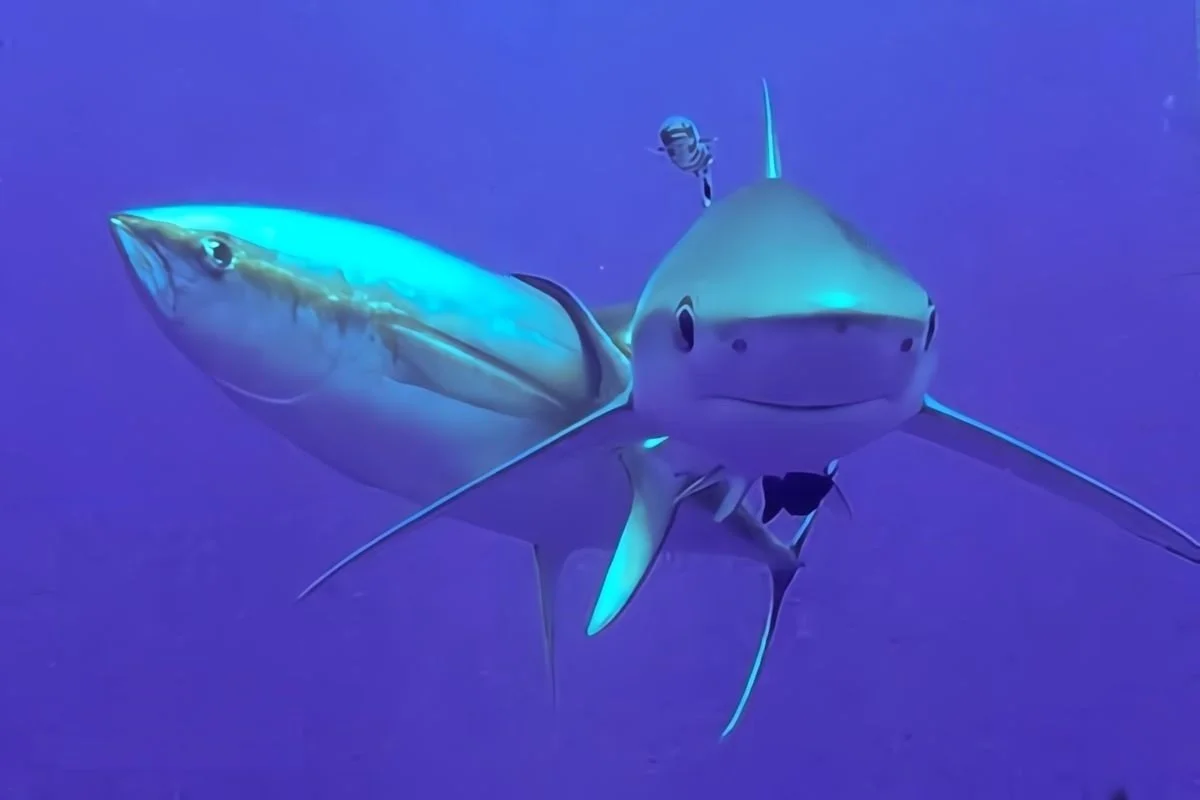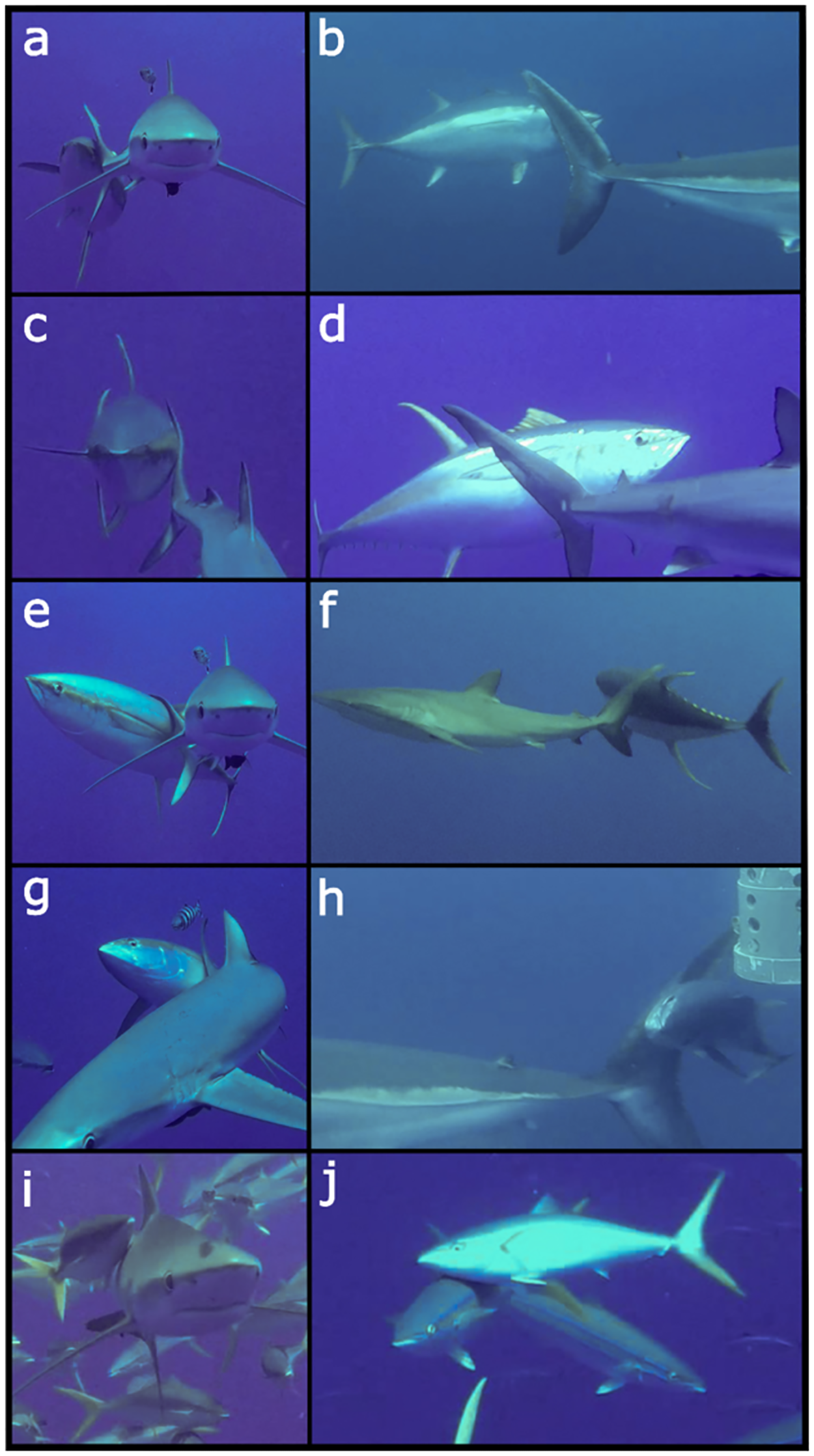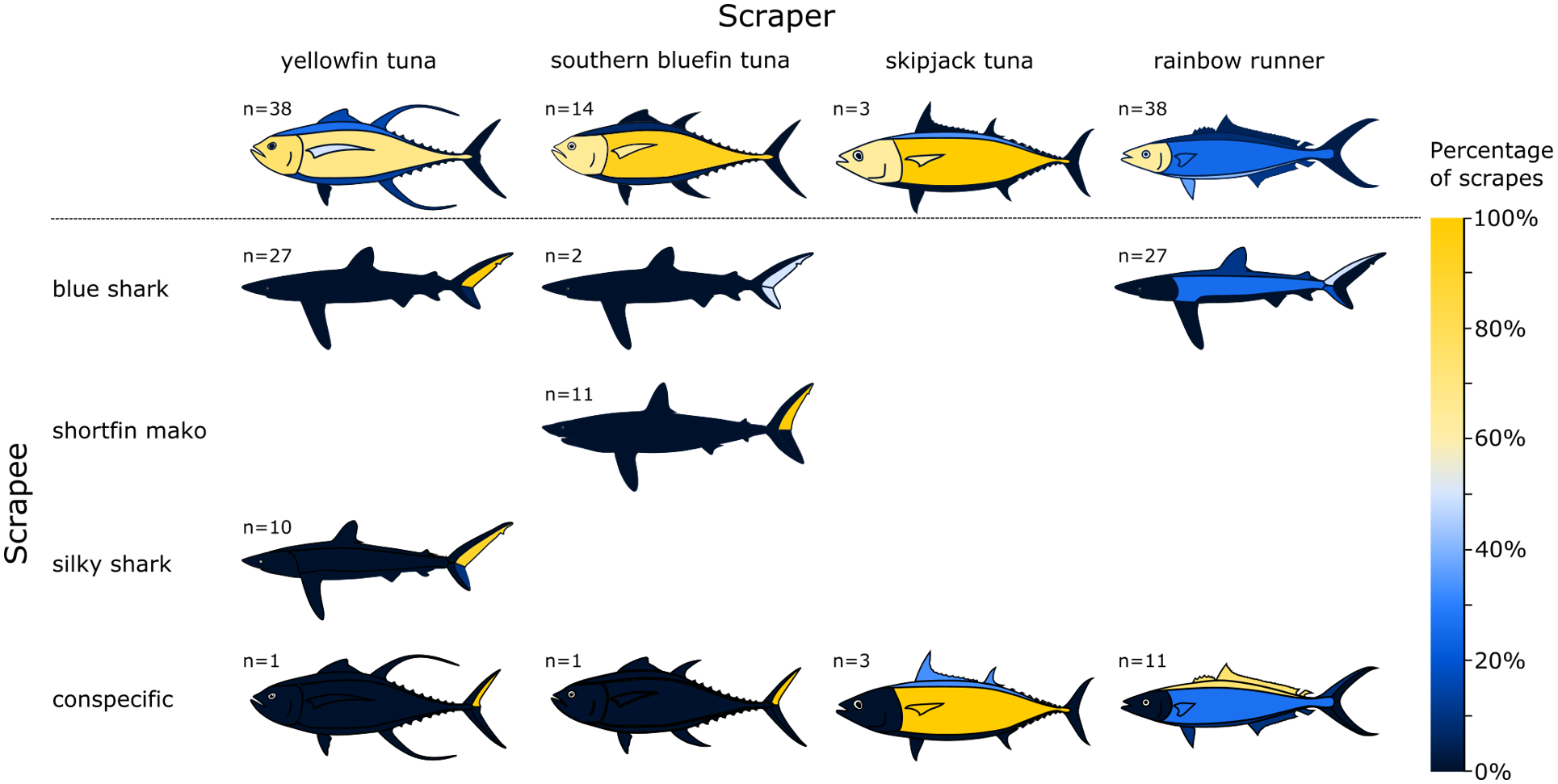2012-2019 | The open ocean
Wild tuna (Thunnus spp.) shark scraping
Humans tools can be dangerous. Even something as simple as an axe or a ladder can cause serious injury. But the danger usually comes from our own mistakes—or misfortune—not from the risk of the tool turning around and eating us.
Today we’re going where that risk is real, out into the murky depths where the line between tool use and environmental manipulation gets blurred. A world where some itches just can’t be ignored, no matter the peril. It’s tuna time.
Remote control
From 2012 to 2019, boats across the world dropped small cameras into the open ocean. Known as Baited Remote Underwater Video Systems (or BRUVS), these cameras were deployed to film, count and measure as many individual animals as possible, in a global survey of marine life. The BRUVS collected footage from Australia, Mexico, Tonga, the United Kingdom and more.
This is the typical set-up, with stereo cameras on a platform facing a baited cylinder that attracts passing animals:
These surveys have been a resounding success, identifying numerous species from each camera location. As an example, this short film shows the variety of marine animals found in a submarine canyon just off the coast of Perth in Western Australia:
The BRUVS are video cameras, so identification isn’t their only trick. They also capture snippets of behaviour. And among almost 120,000 individuals from 261 different taxa, spotted during more than 6000 BRUVS deployments, an odd activity caught the eye of Christopher Thompson and Jessica Meeuwig. Both researchers are based at the Marine Futures Lab of the University of Western Australia, where they help ensure the health of our oceans by monitoring both animal and human activity.
It was a particular aspect of fish health that grabbed their attention. Pelagic fish live in the open water, spending their lives in the water column without nearing the solid surfaces of the shore or seabed. Like animals everywhere, though, pelagic fish get parasites. By attaching themselves to a fish an ectoparasite (external ones) can feed off their host without the larger animal being able to do much about it. As well as potentially causing sickness or interfering with a fish’s senses, the parasites can cause extra drag through the water, costing the host energy as it swims.
To state the obvious, fish lack hands and the flexibility to pick parasites off their own bodies. One solution might be to visit a cleaner wrasse who can do the job instead, but those are tropical reef fish, and they don’t make house calls to the open sea. Ideally there would be some kind of rough surface against which you could rub your scales, but there are no rocks or trees nearby either. What to do?
You know where this is going. Thompson and Meeuwig pored over the BRUVS footage and found three sites where it looked like one fish was rubbing itself against another one. At spots near Ascension Island, the Recherche archipelago and the Revillagigedo archipelago, the milieu of species attracted to the baited cameras included fish that were intentionally bumping into other animals. And while the bumper was usually a type of tuna, the bumped-against thing was often a live shark.
Here’s a figure from the 2022 paper reporting this work:
Which species are we seeing here? The bottom two photos show rainbow runners (Elagatis bipinnulata) scraping against a blue shark and other rainbow runners. All the rest show either southern bluefin (Thunnus maccoyii) or yellowfin (Thunnus albacares) tuna. They are deliberately scraping themselves against a variety of deadly predators: blue sharks (Prionace glauca) at Ascension Island in images a, c, d, e and g; shortfin mako sharks (Isurus oxyrhinchus) at Recherche Archipelago in photos b and h; and a silky shark (Carcharhinus falciformis) at Revillagigedo Archipelago in image f.
These are widely separated sites—Ascension lies in the Atlantic midway between Brazil and west Africa, Recherche is off the Australian southern coast, and the Revillagigedo islands are west of Mexico in the North Pacific—so this behaviour has likely emerged independently around the world.
Caudal effect
But there’s more. Look again at those images, and you’ll see that the tuna aren’t just randomly rubbing themselves all over a passing shark. They seem to be targeting one specific area. In the words of the researchers, the tuna
always scraped on the posterior margin of the caudal fin and almost invariably scraped on the upper caudal lobe.
Caudal means the tail region, so the tuna were deliberately rubbing themselves on the upper part of the shark’s tail. This excellent graphic from the report shows that preference nicely. Along the top are the scraping fish, and below them their targets (including both sharks and other fish of the same species), with the target areas highlighted:
There’s a clear species difference here, with most tuna going for shark tails, and the rainbow runners happy to rub themselves all along a shark, or a fellow rainbow runner for that matter.
Why go after sharks in the first place, though, given the risks? It’s all about that skin. Shark skin isn’t like our own, in fact it’s more like a flexible material covered in little teeth: a shark’s overlapping skin-plates have even been termed ‘denticles’. These face away from the head, so a swimming shark cuts cleanly through the water. In the other direction—which is where the tuna are coming from—the effect is more like running into enamel-tipped sandpaper.
Here’s a scanning microscope view of the tail scales of an Atlantic sharpnose shark (Rhizoprionodon terraenovae), from another recent study by Harvard biologists Molly Gabler-Smith and George Lauder. On the right is a cross-section of one scale, less than half a millimetre in length, showing its detailed ridges:
There was nothing accidental about the tuna’s behaviour in these interactions. They would carefully line themselves up behind a shark, then rush forward as it swayed towards them, scraping quickly with their gills closed and fins tucked in, before fleeing sideways away from the predator. The scientists found that a kind of waiting room could even form, where
When multiple tuna were present, they would take turns to scrape, forming a chain with the tuna that had just scraped usually returning to the end of the queue.
The regularity and relative slowness of shark tail sweeps, and the flexible tail, likely helped build this odd dependancy. It also helps that none of the scraped sharks reacted to the fish as they darted in and away. And when the researchers compared the size of the tuna and its shark-shaped emory board, they found that it was larger tuna that were scraping themselves. The scraping fish may have simply been too big for the sharks to catch and eat—although smaller members of the same species are definitely on the menu.
The BRUVS system doesn’t have the resolution to count parasites on a fish face, but there seems little doubt that removing pests is the main reason for the tuna-rubbing sessions. Parasites can affect tuna eyesight, as well as disrupting the important sensory mechanism along the fish’s body known as the lateral line. Hopefully Thompson and Meeuwig’s findings will spur further research into exactly how this all helps the tuna, as logistically tough as that research might be out among the waves.
A tall tail?
Because this is a blog about tool-using animals, we do need to consider whether these tuna are really using tools or not. It’s a difficult call: at no point does the fish grab hold of the shark or position it just right to get the perfect scrape. The fish doesn’t change the position or form of the shark at all, it just sneaks up, scrapes and runs away. Most tool-use definitions would give up and deny the tuna at this point, putting their actions in the same bucket as an itchy cow rubbing itself on a fence post, or a bear on a tree, or an Arctic bowhead whale scratching its back on a submerged rock:
On the other hand, there is also clear planning, and (in a looser sense) manipulation happening here. The shark is a mobile mass, not attached to a solid surface, and one with clearly defined safe and dangerous ends. The tuna can’t just lazily scratch itself without risking serious harm. The movements that we might make with our hands while using a tool, brushing our hair or using a cloth to wipe our face, are translated into whole body coordination by the tuna. The scraping behaviour is repeated, purposeful, and shared by more than one species as an efficient solution to a troubling problem. It may even involve an awareness of the relative size of the tuna itself to the shark swimming ahead, as part of a fishy cost-benefit analysis.
Ultimately, the shark’s tail, and therefore the shark itself, are as close to a tool as the tuna is going to find during a life in the open water. Should we begrudge it doing its best with what evolution and the local environment has provided? It’s true that what these fish are up to doesn’t match our human-centred ideas of how a tool is used, and how alive it usually is at the time. But if something as interesting and widespread as shark scraping doesn’t fit our definitions, could it be that we, and not the tuna, are the ones who need to get a better grasp on the situation?
Sources: Thompson, C. & J. Meeuwig (2022) Sharks are the preferred scraping surface for large pelagic fishes: Possible implications for parasite removal and fitness in a changing ocean. PLoS ONE 17(10): e0275458. || Bouchet, P. et al. (2020). Marine sampling field manual for pelagic BRUVs (Baited Remote Underwater Videos). In Field Manuals for Marine Sampling to Monitor Australian Waters, Version 2. Przeslawski R, Foster S (Eds). National Environmental Science Program (NESP). || Gabler-Smith, M. & G. Lauder (2022) Ridges and riblets: Shark skin surfaces versus biomimetic models. Frontiers in Marine Science 9:975062. || Fortune, S. et al. S (2017) Evidence of molting and the function of “rock-nosing” behavior in bowhead whales in the eastern Canadian Arctic. PLoS ONE 12: e0186156.
Main image credit: Adapted from Thompson & Meeuwig (2022) || Second image credit: Bouchet et al. (2020); https://pelagic-bruvs-field-manual.github.io || First video credit: Marine Futures Lab, University of Western Australia; https://www.youtube.com/watch?v=QqrRT43pjEM || Third and fourth image credits: Thompson & Meeuwig (2022) || Fifth image credit: Gabler-Smit & Lauder (2022) || Second video credit: Fortune et al. (2017)




